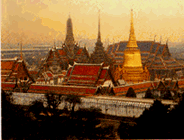|
 The
resplendent Grand Palace, a 60-acre enclosure on the Chao
Phraya River, is one of Thailand's best-known landmarks. The
earliest buildings in the palace compound, regarded as masterpieces
of classic Thai architecture, were constructed in the reign of
King Rama I, founder of the Chakri Dynasty. Subsequent
rulers have made extensive additions in both Thai and western
styles. Though the King no longer makes his home in the Grand
Palace, its historic buildings are, nonetheless, still used for
most of the important ceremonies associated with the Thai monarchy. The
resplendent Grand Palace, a 60-acre enclosure on the Chao
Phraya River, is one of Thailand's best-known landmarks. The
earliest buildings in the palace compound, regarded as masterpieces
of classic Thai architecture, were constructed in the reign of
King Rama I, founder of the Chakri Dynasty. Subsequent
rulers have made extensive additions in both Thai and western
styles. Though the King no longer makes his home in the Grand
Palace, its historic buildings are, nonetheless, still used for
most of the important ceremonies associated with the Thai monarchy.
Royal coronations, for example, take place in the Phra Thinang Paisan Thaksin, one of a group
of early structures of royal residences and throne halls within the Grand Palace compound
known as the Phra Maha Monthien. This magnificently decorated hall contains among other
things the Octagonal Throne, from which the King formally receives the invitation from
representatives of the people to rule over the kingdom. It also holds the Phatthrabit Throne,
from which His Majesty receives the Royal Regalia, the Royal Utensils, and the Royal Weapons
of Sovereignty. The adjoining Phra Thinang Amarin thara Winitchai originally served as the principal
audience hall, and is still used for the grand audience on His Majesty's royal birthday anniversary
and for royal religious ceremonies throughout the year. The Amarinthara Winitchai Hall is the interior
part of a system of chambers, the last of which was originally used a s a place of residence.
The Phra Thinang Dusit Maha Prasat Throne Hall, also built by King Rama I, provides the setting
for the annual Buddhist and Brahmin coronation day anniversary rites. It is also a custom to
place the remains of kings, queens, and senior members of the Royal Family in this hall prior to
their cremation. This ritual was most recently performed when Her Majesty Queen Rambhai
Bharni of the Seventh Reign was given an elaborate traditional funeral in 1985.
The Phra Thinang Chakri Maha Prasat, a largely western-style throne hall built by His Majesty's
grandfather, King Chulalongkorn, between 1876 and 1882, is used for royal dinners and
receptions. King Bhumibol Adulyadej also uses it to receive the credentials of newly arrived
foreign ambassadors to Thailand.
 Wat Phra Kaeo, the Temple of the Emerald Buddha, which
occupies one section of the Grand Palace compound. It was built
by King Rama I in 1782. Being the only temple that has no resident
monks, it serves as the royal chapel and houses Thailand's most
revered Buddha image,the Emerald Buddha. His Majesty performs
a number of important religious ceremonies here during the year,
among them the ritual changing of the image's jewel-encrusted
regalia at the beginning of the hot, cool, and rainy seasons.
Wat Phra Kaeo, the Temple of the Emerald Buddha, which
occupies one section of the Grand Palace compound. It was built
by King Rama I in 1782. Being the only temple that has no resident
monks, it serves as the royal chapel and houses Thailand's most
revered Buddha image,the Emerald Buddha. His Majesty performs
a number of important religious ceremonies here during the year,
among them the ritual changing of the image's jewel-encrusted
regalia at the beginning of the hot, cool, and rainy seasons.
The painting on the wall behind the Emerald Buddha represents the Buddhist cosmology:
heaven, earth and hell; whereas the one in front shows the scene of the enlightenment of the
Buddha. Those on the two-side walls depict episodes from the life of the Buddha and also his
previous lives.
In the precinct of the Temple of the Emerald Buddha is also located the Royal Pantheon.
This pavilion houses the statues of the deceased kings of the present dynasty and is open to
the public once a year on the 6th of April, the Chakri Day.
One of the most interesting spots in the temple is model of Angkor Wat, the beautiful and
imposing Khmer architecture of the 12th century.
|